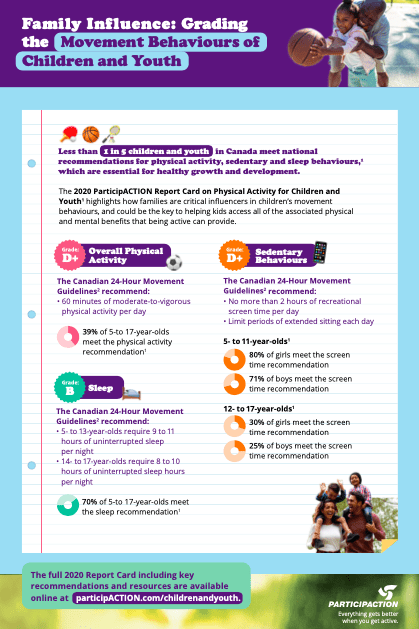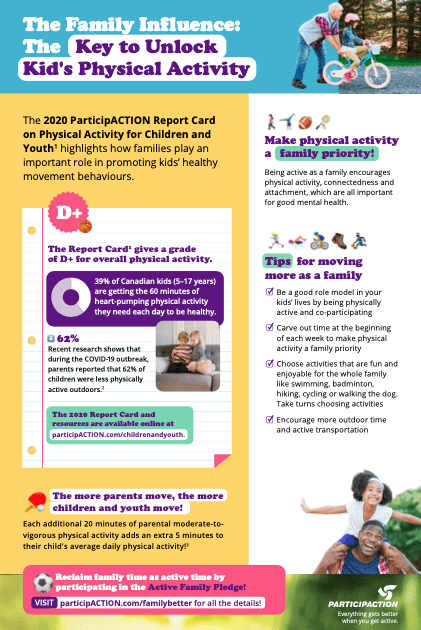DR. JOHN SPENCE ON THE 2020 PARTICIPACTION REPORT CARD
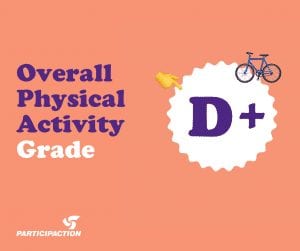
For the past 14 years, ParticipACTION has released report cards that grade Canadians on their physical activity behaviours. The report cards bring together data from a variety of sources to give evidence-based grades on a number of different indicators. Dr. John Spence is a Professor and Vice Dean at the University of Alberta within the Faculty of Kinesiology, Sport and Recreation and is part of the ParticipACTION Report Card Research Committee. He was kind enough to answer a few of our questions about the report card and how it related to schools.
Dr. Spence is a good friend to Ever Active Schools and we most appreciate his time. Below is an interview that we did as the 2020 report card was released this week. We hope that the attention to physical activity encourages decision makers to clearly under its importance to overall well-being and specifically within a school and learning environment.
Ever Active Schools (EAS): The overall grade was a D+ for children and youth physical activity levels this year, but the ParticipACTION report was researched and compiled pre-COVID. Any thoughts on how COVID has impacted physical activity levels with children and youth?
Dr. John Spence (JS): We see that children are less active than they were pre-COVID. Not surprisingly, things like playing outdoors on playgrounds and organized sport were restricted or limited. In addition, any activities that required children to go to facilities were down dramatically. Also and not surprisingly screen time with children is higher than it would typically be. So yes, there’s been a (hopefully temporary) impact of COVID and COVID-related restrictions on the physical activity, sedentary behaviour and sleep of children.
EAS: One of the key stats in the ParticipACTION report card is each additional 20 minutes of moderate to vigorous physical activity by a parent is associated with an additional 5 minutes in their child’s daily physical activity. This speaks to parental influence, which is a big focus of the report card this year. Is there anything else that we can take from that statement?
JS: The theme of the ParticipACTION report card this year is that the “family counts”. Family influences the healthy movement behaviours of children in a number of different ways, such as guidelines around going to bed, using screens when children are in their bedroom, the amount of screen time they’re allowed to consume and so forth.
On the physical activity side, there’s a number of different ways that the family and parents influence and support their childrens’ physical activity. Everything from encouraging children to go outside and play to taking the children to organized sport events, but this statistic in particular is speaking to the parent or supportive adult role-modeling physical activity. This could be in a number of ways: the child is seeing the parent being physically active, but then there is co-participation and that’s what the report card is really supporting or suggesting – that parents engage their children and co-participate in activities if they can. We see there is a role for parents and supportive adults to play, and the evidence supports that when they model physical activity and participate with their children, children are more active.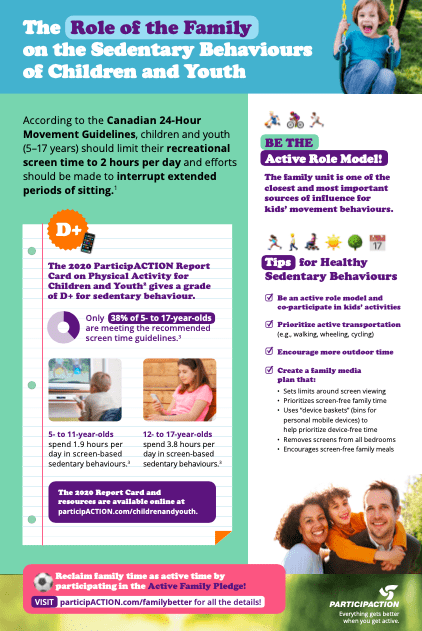
EAS: There were a lot of recommendations to schools including policy, quality implementation of the health & physical education curriculum and healthy movement behaviours, and a supportive environment. Within a school setting, what is your opinion on the key recommendations in the highlight report?
JS: Within the school, children usually sit down during classes. We want to start thinking of ways to facilitate physical activity apart from your traditional Physical Education (PE) class, lunchtime or recess. Similarly, children have to commute to and from school. Are there ways to facilitate more active transportation during that commute, like safe zones around the school? This is where the parent or guardian interaction with the school is critical. We were previously talking about supportive behaviours by parents or guardians primarily in the home context, but they can be advocating for schools to be more supportive of healthy movement behaviours, less sitting and more activity in and around the school.
One of the recommendations that we may not have talked about before in the report card is this notion of assigning healthy movement behaviour homework. I like that as an idea to improve physical activity, and I’d be interested to hear what teachers have to say about that. I think that one of the challenges for schools and teachers is what is their jurisdiction, and what are they responsible for? Generally they’re responsible for the child when they’re in the school and perhaps leaving and coming to school, and some after-hours in some cases. But I’d be interested to hear what teachers think about this notion of providing or requiring healthy movement behaviour homework. It’s sort of a way of illustrating the role that a school could be playing as part of a broader supportive network in the community.
EAS: We thought that was a really interesting recommendation listed in the ParticipACTION report. What would you think would be some good healthy movement behaviour homework assignments for teachers to give?
Going back to Daily Physical Activity (DPA) initiatives, teachers can incorporate things related to physical activity, sleep, and sedentary behaviour in other parts of the curriculum other than PE. So for example, the child has to keep track of the number of steps they take, or record the amount of time they’ve spent doing physical activity as part of their homework. Maybe they have to describe the activities that they’re doing with their family that would count as physical activity or sedentary behaviour. Instead of saying “go home and run around,” perhaps you try to tie it to lessons in other classes.
EAS: So making those cross-curricular connections, where physical activity could be incorporated into math or science homework?
JS: Yes, if they have to add something up why not get them to add up something related to the number of minutes or time they’re spending doing physical activity? I know the challenges teachers and schools experience in some of these areas, so maybe it’s a way of integrating healthy movement behaviours as opposed to adding on additional work.
 EAS: The ParticipACTION report card is 14 years old, and at times people just see a poor grade. We really tend to hang around the D grade and have been there for the past number of years. Can you summarize where we have improved and where we still need improvements?
EAS: The ParticipACTION report card is 14 years old, and at times people just see a poor grade. We really tend to hang around the D grade and have been there for the past number of years. Can you summarize where we have improved and where we still need improvements?
JS: Well one place we have improved is on the overall grade. There have been F grades in the past, and I’d take a D+ over an F. Related to that, I hear it from colleagues and practitioners that there’s a sense of learned helplessness, that we’re just never going to be able to improve on the grade. It’s important to remember this grade is the proportion of children who are meeting the physical activity guidelines. If you look at the average or median minutes children are engaging in physical activity, they are oftentimes at or above the recommended 60 minutes per day. We generally need kids to add on only a few more minutes in their day to meet the physical activity guidelines.
There is also a distinct gender difference – girls engage in less moderate to vigorous physical activity than boys do, particularly adolescent girls. Weekends are the worst for children overall when it comes to time spent being physically active. If we were going to try and make some progress on the grade, we need to be targeting weekends. Organized sport is not necessarily the solution there because we’re pretty good in terms of our engagement in organized sport. It does play a role. We could be focusing more on what’s happening in our communities for our kids on weekends, particularly for adolescents and especially for adolescent females.
We do quite well in some of our main settings like schools. The built environment, access to facilities for example, for most Canadians is pretty good. It’s primarily rural and remote areas of the country where there is less access to facilities.
Policies and government support in the past few years have been positive – we’ve seen government support with the release of A Common Vision, the national physical activity strategy. We will need continued evaluation and support of the strategy so we can see the overall impact and changes of this strategy.
Screen time is a major culprit now, in terms of contributing to the overall healthy movement behaviour grade. Many children are far exceeding the 2 hour limit per day, which brings down the overall grade.
EAS: You mention that weekends were some of the more challenging times to get children and youth active. We know that the school day is quite structured, and there exist a lot of policies to promote physical activity through physical education classes, daily physical activity (DPA) policies, etc. Can you think of strategies or ideas that could help to get kids more active on those evening and weekend times where the structure isn’t necessarily the same as a school day?
JS: When you take the school day out of a child’s life, it’s upwards of 2000-2500 steps that are gone from their day. That doesn’t necessarily mean that they’re walking to and from school, it’s also how much walking they’re doing around the school, the movement they do in physical education class, and so forth. The absence of the school and requirement that the child is physically going to the school does have an impact. If they are not purposely engaging in other activities, they may only be getting up to their “leisure time” activity levels. They’ve lost their activity related to going to and from, and hanging out at school. That’s definitely what we see on the weekend compared to weekdays. It’s also an effect that we would see in the COVID context where children are having to stay at home.
The challenge for parents or guardians, if they’re working at home in a COVID context, is how to facilitate their child’s activity while they’re trying to work. I’m hearing that the screen becomes a proxy or babysitter in that situation.
Regarding the traditional weekend/weekday comparison, one of the challenges is how children and youth (and particularly adolescent girls) socialize. There was a time when you would walk or ride your bike to the mall to hang out with your friends, but now you can socialize on a screen. In fact, that’s the big difference between boys and girls in how they use screens – for girls, it’s socializing. One of the approaches we can take is fostering different types of social engagement and interaction that also happen to have a physical activity component.
EAS: Much of this evidence isn’t new, but we’re talking about it now because of the ParticipACTION report card release. How do we maintain the attention around the importance of physical activity every day?
importance of physical activity every day?
JS: If I had the answer to that, I would potentially be a Nobel prize nominee! If we can work to support the school setting and help parents, that’s a good starting point. It’s also not a “blame the parents” message, but we want to reinforce to parents and supportive adults that they play a critical role in their child’s healthy movement behaviours. This is everything from the decision of what activities your child engages in to how you facilitate it, and that parents are a role model for physical activity.
It’s important to continue speaking to governments at all levels (municipal, provincial, federal) and to work with decision makers in key settings. Unfortunately in the context of COVID it’s pretty hard to get any other messages out right now. Although, interestingly, there have been a lot of stories about people going outside, walking around, people being surprised by how many other people they see outside playing and being active. There’s been a little bit of attention paid to physical activity in the context of COVID.
Ultimately it’s a matter of plugging away and trying to convince the powers that be (whoever they are) that we’re not talking solely about organized sport, which is the stereotypical image of what we mean by physical activity. Certain organizations, jurisdictions and settings are saying “we’re not into sport” – but it’s about how people stand up, move around, and keep their heart pumping at a healthy rate.
EAS: Any other key highlights that we need to take away from the ParticipACTION report card?
JS: Overall ParticipACTION does a very good job placing a premium on evidence. The theme of “family” this year and all the recommendations put forth are backed up by systematic reviews. The main task and responsibility of the committee I sit on is to bring forward the best research and evidence over the past two years, so if you want a one-stop shop to learn what’s going on regarding healthy movement behaviours for kids this report card is definitely a place to start.
EAS: You’re now in charge of physical activity for Canada, and you have an unlimited budget. What are the first things you do?
JS: In the context of children’s physical activity, I would have an emphasis in the school setting on quality daily PE experience. I think it’s critical. We need, from primary all the way up to secondary schools, PE being taught by people who are trained HPE specialists.
If we want to foster physical literacy, we need people with that training, particularly in the primary schools. This is one of the areas where I see a major limitation, that in perhaps the most important phase of development children are not being exposed to specialists who know how to foster physical literacy. So if I had an unlimited budget, I would ensure that we have quality daily physical education experiences for all children and youth.
I would advocate for and support DPA on top of that – reinforcing those things that are perhaps outside of or around the school setting.
I would also be finding ways to provide or facilitate access to organized sport and physical activity opportunities for children living in low income households. This is critical and something that we need to fix. Canada’s a relatively wealthy country in the world, we shouldn’t have one child who cannot participate because of their household income status. I’ve done quite a lot of work in that area and it’s frustrating to me that there are still children who cannot participate because their family doesn’t have enough money.
Those would be several things that I would do.
EAS: Anything else you would like to add?
JS: I hope that the role that schools play in healthy movement behaviour is valued and apparent.
EAS: Thank you Dr Spence. We are grateful for your time on a busy day.
For resources that support students in staying physically active throughout the school day, check out our Don’t Walk in the Hallway floor decal sets, or Don’t Sit Still In Class downloadable resource.
